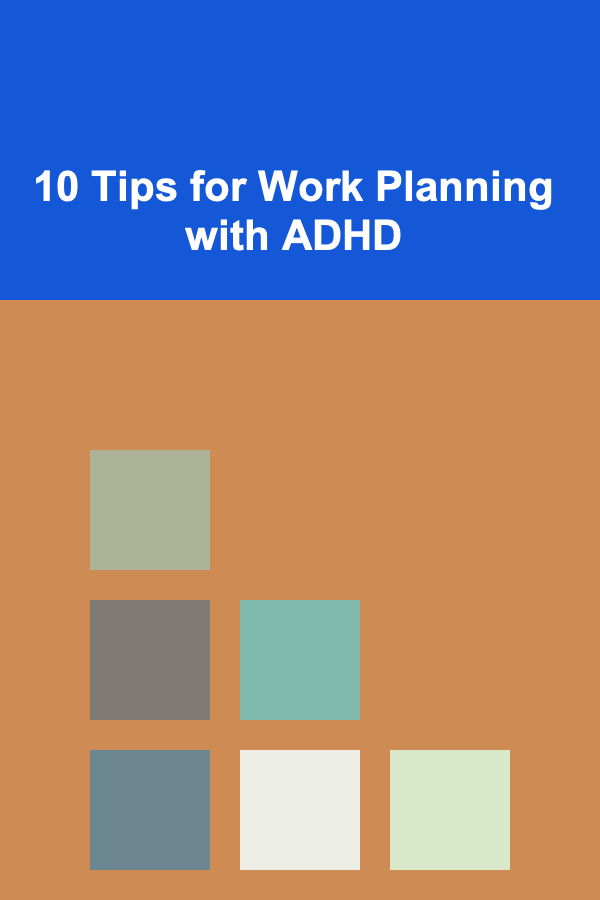
10 Tips for Work Planning with ADHD
ebook include PDF & Audio bundle (Micro Guide)
$12.99$8.99
Limited Time Offer! Order within the next:

Managing work effectively while navigating the challenges of ADHD (Attention Deficit Hyperactivity Disorder) can be a daunting task. The unique characteristics of ADHD, such as difficulties with focus, organization, time management, and impulsivity, can make traditional work planning methods seem overwhelming or ineffective. However, with the right strategies, individuals with ADHD can develop work plans that play to their strengths, mitigate challenges, and improve productivity.
In this article, we'll explore ten effective tips for planning your workday, managing tasks, and staying organized with ADHD. Whether you're juggling multiple projects, managing deadlines, or trying to increase your focus, these tips will help you stay on track and achieve your professional goals.
Break Tasks into Smaller, Manageable Steps
One of the most common challenges faced by individuals with ADHD is the feeling of being overwhelmed by large, complex tasks. A project that requires several hours or even days of work can seem like an insurmountable obstacle, causing procrastination and difficulty starting.
Solution: Use the "Chunking" Method
Instead of tackling a large task all at once, break it down into smaller, more manageable chunks. Each chunk should represent a step in the process, and once completed, you can move on to the next. This strategy helps make daunting tasks seem more achievable and provides a sense of accomplishment as you finish each step.
For example, if you need to write a report, break it down into steps like:
- Research and gather materials
- Write the introduction
- Write the body of the report
- Edit and revise
By breaking tasks into smaller chunks, you're less likely to become overwhelmed and more likely to stay focused on the task at hand.
Use Visual Tools for Task Management
Traditional lists and calendars may not be effective for everyone with ADHD, especially if the visual cues aren't stimulating or engaging enough to capture attention. Visual tools like color-coded planners, task boards, or digital apps with interactive features can help make work planning more engaging and effective.
Solution: Use Visual Apps or Task Boards
Apps such as Trello, Todoist, or Asana offer visually stimulating ways to organize tasks, with color-coded categories, icons, and easy drag-and-drop interfaces. These tools can help keep tasks organized while providing visual reminders of what's important and when things are due.
Additionally, using a physical task board, such as a whiteboard or sticky notes on a wall, can create a visual environment where your to-do list is constantly in front of you. The physical act of moving tasks from one category to the next---such as from "To Do" to "In Progress" to "Completed"---helps create a sense of accomplishment and keeps tasks at the forefront of your mind.
Use Timers and Time Blocks
Time management is one of the most difficult aspects of work planning with ADHD. A tendency to lose track of time or become hyper-focused on one task while ignoring others can lead to disorganization, missed deadlines, or unproductive work hours.
Solution: Time Blocking and the Pomodoro Technique
A helpful strategy is to use time blocking, which involves dedicating specific periods of time to particular tasks. You can use timers or alarms to set the start and end times of each block. The Pomodoro technique, for instance, suggests working in 25-minute intervals followed by a 5-minute break. After four cycles, take a longer break.
By giving yourself set periods of time to work on tasks, you can create a structured yet flexible schedule. Time blocking helps with focus by limiting distractions during work intervals and allowing you to take necessary breaks, which are vital for maintaining productivity.
Prioritize Tasks Using the 1-3-5 Rule
Prioritization is essential when you have ADHD, as your attention can easily shift between tasks, leaving important projects unfinished or neglected. By using a structured approach to prioritize tasks, you can ensure you're tackling the most important things first, without getting sidetracked.
Solution: The 1-3-5 Rule
The 1-3-5 rule is a simple and effective prioritization method that helps you decide which tasks should take precedence each day. Each day, select:
- 1 big task that will take the most time or effort.
- 3 medium tasks that are important but less complex.
- 5 small tasks that are easy to complete and can be done in a short amount of time.
By breaking your to-do list into these categories, you can focus your energy on the big task without neglecting smaller but necessary duties.
Establish Routines and Consistent Work Hours
One of the key strategies for managing ADHD is creating a routine that eliminates decision fatigue. When you rely on routine, your brain doesn't have to work as hard to plan or decide what to do next, which reduces the likelihood of getting distracted.
Solution: Create a Fixed Daily Schedule
Set consistent work hours and create routines that repeat every day. Having set times for things like checking email, completing certain tasks, or taking breaks can prevent procrastination and ensure that you stay on track. Make sure that your routine includes time for personal tasks, self-care, and recreation as well, to prevent burnout.
You can also use reminders or alarms to stay on top of your schedule. Many people with ADHD find that having external cues (such as reminders from a smartphone or calendar app) helps them stay on task.
Reduce Distractions and Create a Productive Workspace
A common ADHD symptom is the tendency to be easily distracted, which can drastically affect productivity. Having a work environment that minimizes distractions is crucial for staying focused and on task.
Solution: Create an ADHD-Friendly Workspace
Design a workspace that helps you stay organized and free from distractions. A clutter-free desk, minimal background noise, and a space designated solely for work can increase your ability to focus. If possible, use noise-canceling headphones or white noise apps to block out distractions from your environment.
Keep essential work items in a visible, organized manner, so you don't waste time searching for things. Using bins, files, or storage solutions can help reduce clutter and improve focus.
Utilize Accountability Partners or Work Groups
Accountability can be a powerful motivator for staying on task and meeting deadlines. With ADHD, it can be easy to get sidetracked or push tasks aside, so having someone to check in with can keep you on track.
Solution: Find an Accountability Partner or Team
Find a colleague, friend, or mentor to check in with regularly on your progress. This could involve weekly meetings to discuss your goals, review completed tasks, and set new priorities. Knowing that someone else is aware of your progress can provide the extra motivation you need to stay focused.
Alternatively, if you're working on a team project, use collaborative work tools like Slack or Microsoft Teams to keep everyone updated. Setting group goals or milestones can make you more invested in the process and prevent procrastination.
Practice Self-Compassion and Avoid Perfectionism
One of the most common pitfalls for individuals with ADHD is perfectionism. The desire to do everything perfectly can lead to delays, frustration, and burnout. If you're consistently worried about mistakes or falling short of expectations, it can be difficult to maintain momentum and make progress.
Solution: Embrace "Good Enough"
While it's important to produce high-quality work, it's equally important to recognize when a task is "good enough." Try to let go of the need for perfection, and focus on making progress rather than achieving flawless results. Celebrate small victories and remind yourself that the process of completing tasks is just as valuable as the outcome.
Being kind to yourself when things don't go according to plan helps reduce anxiety and makes it easier to get back on track.
Incorporate Regular Movement Breaks
Sitting for long periods can be challenging for individuals with ADHD. Physical activity is not only good for your body but also for your mind. Regular movement helps boost focus, reduce restlessness, and improve productivity.
Solution: Build Movement Into Your Day
Incorporate short, regular breaks that include some form of physical activity. This could be as simple as standing up to stretch, going for a quick walk, or doing a few minutes of jumping jacks. The key is to get your body moving to release pent-up energy and reset your brain for the next task.
If you're working at home, consider using a standing desk or a walking treadmill to reduce sedentary behavior. Some individuals with ADHD find that alternating between sitting and standing positions throughout the day helps maintain focus.
Reflect and Adjust Regularly
No work plan is perfect from the start, especially when you have ADHD. It's essential to regularly reflect on your strategies and make adjustments based on what's working and what's not.
Solution: Regular Check-ins and Adjustments
At the end of each week, take some time to evaluate how well your work planning strategies are working. Are you meeting your goals? Are there certain tasks or strategies that need to be improved? Make adjustments as necessary and be willing to try new approaches.
Reflection and adjustment allow you to stay flexible and improve your planning system over time, which will help you better manage your work with ADHD.
In conclusion, planning and managing work with ADHD requires a tailored approach that accounts for the unique challenges posed by the condition. By using strategies like task chunking, visual tools, time blocking, and self-compassion, individuals with ADHD can create a work plan that is not only effective but also sustainable. Remember, the key to success is finding a system that works for you and being willing to adjust it as needed. With patience, practice, and the right tools, you can overcome the challenges of ADHD and thrive in your professional life.
Reading More From Our Other Websites
- [Whitewater Rafting Tip 101] From Beginner to Pro: A Step-by-Step Guide to Planning Your First Rafting Trip
- [Toy Making Tip 101] DIY Miniature Toy Workshop: Simple Projects Kids Can Build at Home
- [Organization Tip 101] How to Set Up a Craft Area That Stays Organized
- [Home Security 101] How to Install Motion Sensors for Enhanced Home Security
- [Rock Climbing Tip 101] Layering Like a Pro: The Ultimate Guide to Year-Round Climbing Clothing
- [Organization Tip 101] Why Understanding Feng Shui Can Help with Organization
- [Home Renovating 101] How to Convert Your Garage into a Functional Living Space
- [Organization Tip 101] How to Set Up a Family Bathroom Cabinet for All Ages
- [Home Soundproofing 101] How to Use Soundproof Paint to Improve Acoustics and Block Noise
- [Home Renovating 101] How to Create a Luxury Bathroom on a Budget

How to Evaluate and Choose the Right Investment Portfolio
Read More
How to Organize Your Digital Photos for Easy Sharing
Read More
How to Plan for Rainy Days with Indoor Activities
Read More
How to Store Seasonal Decorations Without Overcrowding
Read More
How to Identify Edible Plants While Hiking
Read More
How to Color Bookmarks with Watercolor Pencils
Read MoreOther Products

How to Evaluate and Choose the Right Investment Portfolio
Read More
How to Organize Your Digital Photos for Easy Sharing
Read More
How to Plan for Rainy Days with Indoor Activities
Read More
How to Store Seasonal Decorations Without Overcrowding
Read More
How to Identify Edible Plants While Hiking
Read More